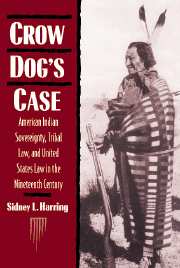 Crow Dog's Case
Crow Dog's Case Published online by Cambridge University Press: 23 September 2009
The foundational case in federal Indian law is Worcester v. Georgia (1832). Known collectively with Cherokee Nation v. Georgia (1831) as one of the “Cherokee cases,” it has been the subject of much analysis, particularly for its formulation of tribal sovereignty. The case precipitated a famous constitutional crisis when President Andrew Jackson remarked, “John Marshall has made his decision, now let him enforce it,” and refused to use federal power to protect Cherokee rights against Georgians. This conflict itself illustrates the core contradiction in Indian law cases during most of the nineteenth century: federal Indian law evolved in a legal battle with the states over federal control of Indians and Indian lands, with tribal sovereignty or the legal rights of native people often not even of secondary concern. Hence, Chief Justice John Marshall's famous pronouncements of Indian rights were virtually meaningless to the tribes.
All modern legal discussions of the Cherokee cases omit consideration of the first such case, Corn Tassel, which, although known to legal scholars because it establishes the context for the more famous cases, is never seen as having doctrinal meaning. In addition to demonstrating the wholesale federal abandonment of treaty obligations toward the Cherokee, the case represents a cowardly cession of both federal power and tribal sovereignty to the states. This action dominates early-to mid-nineteenth-century Indian law.
Corn Tassel's case
All of the Cherokee cases arose from the same tragic violation of tribal rights.
To save this book to your Kindle, first ensure [email protected] is added to your Approved Personal Document E-mail List under your Personal Document Settings on the Manage Your Content and Devices page of your Amazon account. Then enter the ‘name’ part of your Kindle email address below. Find out more about saving to your Kindle.
Note you can select to save to either the @free.kindle.com or @kindle.com variations. ‘@free.kindle.com’ emails are free but can only be saved to your device when it is connected to wi-fi. ‘@kindle.com’ emails can be delivered even when you are not connected to wi-fi, but note that service fees apply.
Find out more about the Kindle Personal Document Service.
To save content items to your account, please confirm that you agree to abide by our usage policies. If this is the first time you use this feature, you will be asked to authorise Cambridge Core to connect with your account. Find out more about saving content to Dropbox.
To save content items to your account, please confirm that you agree to abide by our usage policies. If this is the first time you use this feature, you will be asked to authorise Cambridge Core to connect with your account. Find out more about saving content to Google Drive.